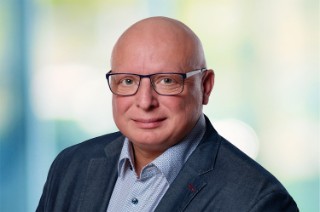1. What inspires your research and what opportunities do you hope to tap into?
The basis of our work is the Fraunhofer ElKaWe flagship project. Here we are collaborating with several Fraunhofer institutes to create a completely new generation of heat pumps that are compact, quiet, efficient, and, above all, free of climate-damaging refrigerants. Instead, electrocaloric heat pumps utilize the electrocaloric effect: special materials heat up when an electrical voltage is applied and cool down again when the voltage is switched off.
However, for this technology to work and be economically viable, it requires high-performance materials that have been developed specifically for this purpose. This is where Fraunhofer IAP comes in: Our goal is to develop innovative and high-performance polymer films with electrocaloric properties at the core of these systems. Our multilayer components made from these electrocaloric films significantly increase the efficiency of electrocaloric heat pumps and thus allow us to harness the enormous potential of this technology for the climate transition.
We see an opportunity here to work with our project partners to create a genuine alternative to conventional heating and cooling systems – for buildings, vehicles, electronic devices, and wherever sustainable temperature
control is required.
2. What successes or insights from your work to date make you feel particularly optimistic? What exciting challenges are on the horizon?
We have succeeded in producing particularly thin and puncture-resistant electrocaloric polymer films and, from these, self-supporting components. These are comprised of up to ten layers of these films – the new international standard. Compared to single films, these multilayer components enable lower operating voltages and thus, in the long term, more cost-effective control electronics with the same efficiency for the heating or cooling system.
A major challenge on the road to commercial use of these components in heat pump systems is transferring the manufacturing processes from a development scale with small quantities to industrial series production. In addition, we are working on further adjusting the temperature window in which the electrocaloric polymers optimally function and are focusing on making the materials even more sustainable.
3. Where could your research have a concrete impact in the future?
First, electrocaloric heat pumps can play a key role in decentralized, energy-efficient heating and cooling. In building technology, these systems could represent a climate-friendly alternative to conventional heating and cooling systems, thereby making a decisive contribution to reducing energy consumption. Thanks to their compact design and the absence of climate-damaging refrigerants, they offer enormous advantages in terms of sustainability and efficiency.
Electrocaloric technology also opens up exciting applications in the area of mobility, such as energy-saving air conditioning for vehicle interiors or efficient temperature regulation for electric vehicle batteries. The use of heat pump technology containing electrocaloric elements represents a significant step toward more sustainable heating and cooling systems.
In the long term, we believe that this technology can play a key role in the transition to a low-carbon future – for both the energy and mobility transitions.
4. In closing, do you have any insights, thoughts, or perspectives that you would like to share with the expert community or the public?
Our work clearly shows that new technologies can only truly be put into practice through the development of innovative materials and their processing methods. Material innovations can make a decisive difference, especially in electro-caloric technology, which is still in the early stages of technical implementation.
That is why we would like to encourage other research institutions and industry to work with us on these future technologies – because the challenges facing the energy transition can only be solved through interdisciplinary cooperation and by joining forces.
